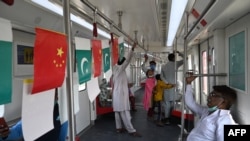The China-Pakistan Economic Corridor, Beijing's massive investment plan to boost trade and economic ties with Pakistan, is 10 years old but has not fulfilled its lofty goals.
CPEC became an early example of China’s Belt and Road Initiative, an aggressive effort to build billions of dollars' worth of infrastructure in Asia and beyond. At its inception, CPEC was China’s most ambitious BRI effort: More than $35 billion was pledged for energy projects and another $10 billion for transportation.
Speaking this month at a commemoration of the project’s 10th year, Ahsan Iqbal, Pakistan’s minister for planning, development and reforms, said that $25 billion in projects had been completed and that the government was now focused on finishing projects originally set for completion by 2020.
He also highlighted the 13 power projects and the 4,000-megawatt electricity transmission line that have been built. At CPEC's outset, the Pakistani government estimated it needed at least another 4,000 megawatts of power that year to meet demand. Officials estimate CPEC projects now provide about one-third of the power for Pakistan’s electrical grid.
Iqbal also touted key roads and ports that have boosted the economy.
“CPEC effectively helped Pakistan in improving the major transport networks from north to south and laid the foundation for a resilient infrastructure including ports, airports and roads and Orange Line Metro Train in Lahore,” he said.
Job creation
Iqbal estimated that CPEC has created more than 230,000 jobs in Pakistan. In May, Chinese official state media estimated that Pakistani workers held about 155,000 of those positions.
Haroon Sharif, the head of Pakistan’s Board of Investment in 2018-19, is skeptical that many of those jobs were created. He told VOA the statistics provided by the government were merely the claims of the planning ministry, not based on third-party assessment.
“The figure could be only credible when it is based on the third-party independent economic assessment,” Sharif said.
Sharif said there are two types of jobs in CPEC projects: temporary and permanent. He said the temporary laborers work until projects have been completed, and then permanent workers take over to run them.
“I have serious doubts that they are in hundreds of thousands, but it could be a few thousand jobs,” he said.
Unfinished projects
Authorities say most CPEC projects begun in 2013 with 2020 deadlines have been completed. However, Pakistan is still setting up nine special economic and industrial zones where Chinese companies are expected to invest. Authorities say four of the zones are under construction while work on the others hasn't started.
At this month's anniversary ceremony, Iqbal blamed the previous government for the delay in completing the zones, though he provided no details.
Sharif attributed the slowdown to Pakistan’s political turmoil as well as COVID-19, since China closed its borders because of the pandemic.
Chinese Foreign Ministry spokesperson Zhao Lijian rejected earlier reports that CPEC faced any slowdowns during the pandemic.
Ammar A Malik, senior scientist at AidData, a research lab at the College of William & Mary in Virginia, said the delayed completion of the industrial zones did slow down Chinese investments.
Malik told VOA that China has a lot at stake in its Pakistan investments and could be concerned about the lack of progress in some areas.
“It is in China’s interest that Pakistan achieve political and economic stability,” Malik said.
He also argued that Pakistan should not take Chinese interest and help for granted.
“The success of the CPEC project is conditional to the economic and political stability of the country. If there is continuity in Pakistan’s economic policies, along with political stability, then investment in CPEC and other projects will continue to grow,” Malik said.
Missed opportunities
In 2013, China expressed interest in relocating some of its industries to Pakistan, attracted by lower production costs. This move would have generated employment opportunities and boosted Pakistan's exports.
That largely has not happened. Iqbal, the planning minister, said the lack of progress on the industrial zones has led many Chinese investors to shift their expansion plans to countries like Cambodia, Laos and Vietnam, where production costs are comparatively lower than in China.
Iqbal said the current government is determined to fast-track all CPEC projects.
In an interview with VOA, Pakistani-based economist Ashfaque Hassan Khan said Pakistan's chronic power shortages also have kept the nation from taking full advantage of Chinese investment.
As an example, Khan said that despite the CPEC investments that have brought some relief from energy shortages, the country has not yet been able to use the surplus energy for industrial zone construction.
Khan said China’s confidence in Pakistan would be restored only if there is political and economic stability in the country, and if other foreign investors regarded Pakistan favorably for further business ventures.
This story originated in VOA’s Urdu Service.









